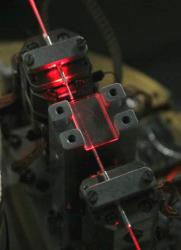Jan 14 2011
Researchers at the University of Calgary, in Canada, collaborating with the University of Paderborn, in Germany, are working on a way to make quantum networks a reality and have published their findings in the journal Nature. A similar finding by a group at the University of Geneva, in Switzerland is reported in the same issue.
“We have demonstrated, for the first time, that a crystal can store information encoded into entangled quantum states of photons,” says paper co-author Dr. Wolfgang Tittel of the University of Calgary’s Institute for Quantum Information Science. “This discovery constitutes an important milestone on the path toward quantum networks, and will hopefully enable building quantum networks in a few years.”
In current communication networks, information is sent through pulses of light moving through optical fibre. The information can be stored on computer hard disks for future use.
 Researchers at the University of Calgary and University of Paderborn designed a quantum memory device using a waveguide in a crystal doped with rare-earth ions.
Researchers at the University of Calgary and University of Paderborn designed a quantum memory device using a waveguide in a crystal doped with rare-earth ions.
Quantum networks operate differently than the networks we use daily.
“What we have is similar but it does not use pulses of light,” says Tittel, who is a professor in the Department of Physics and Astronomy at the University of Calgary. “In quantum communication, we also have to store and retrieve information. But in our case, the information is encoded into entangled states of photons.”
In this state, photons are “entangled,” and remain so even when they fly apart. In a way, they communicate with each other even when they are very far apart. The difficulty is getting them to stay put without breaking this fragile quantum link.
To achieve this task, the researchers used a crystal doped with rare-earth ions and cooled it to -270 Celsius. At these temperatures, material properties change and allowed the researchers to store and retrieve these photons without measurable degradation.
An important feature is that this memory device uses almost entirely standard fabrication technologies. “The resulting robustness, and the possibility to integrate the memory with current technology such as fibre-optic cables is important when moving the currently fundamental research towards applications.”
Quantum networks will allow sending information without being afraid of somebody listening in.
“The results show that entanglement, a quantum physical property that has puzzled philosophers and physicists since almost hundred years, is not as fragile as is generally believed,” says Tittel.
Source: http://www.ucalgary.ca/